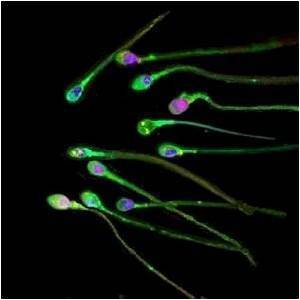
The coating clings to fibrous strings and mats of protein called SEVI-for semen-derived enhancer of viral infection-which was first discovered just three years ago.
SEVI seems to attract the virus and deposit it onto the surface of T-cells, components of the immune system that are the primary target of HIV infection, and may play an important role in sexual transmission of HIV.
Like the fibrous strings that bind senile plaques associated with Alzheimer's disease, SEVI is a kind of protein superstructure called an amyloid.
Jerry Yang, associate professor of chemistry at UC San Diego and his research group developed non-stick coatings for amyloids as a potential treatment for Alzheimer's disease in 2006.
Their idea was to minimize damage by preventing amyloid proteins from interacting with other molecules in the brain.
Advertisement
"We tested one of our molecules out on SEVI and found it was able to stop SEVI-enhanced infection of HIV in cells. It works in semen too. Something in semen enhances viral infection - SEVI and maybe other things. This molecule stops that," said Yang.
Advertisement
They saw a similar effect with semen as well, evidence that this potential microbicide supplement works to inhibit infection within a mixture of proteins and other molecules found in seminal fluid.
The coating molecule is a modified form of thioflavin-T, a dye that stains amyloid proteins. It fits in between the individual small proteins that cluster to form SEVI and blocks SEVI's interactions with both the virus and the target immune cells.
"Other people have tried to do the same thing by targeting the virus or the cells it infects. What we do is target the mediator between the virus and the cells. By neutralizing SEVI, we prevent at least one way for HIV to attach to the cells," said Yang.
The new molecule has another advantage. Unlike many current microbicide candidates aimed at reducing HIV infection, this one doesn't cause inflammation in cervical cells.
"Recent studies have shown for the first time that a topical microbicide gel can protect women from HIV-1 infection. This is a huge step forward but not a perfect solution. We need to figure out ways to further improve protection - and our studies suggest one way of doing so. It may be possible to produce a next-generation microbicide that includes both an antiviral agent, as has been used in the past, and an agent that targets SEVI. We're very excited about exploring this idea," said the corresponding author of the report.
The study has been published in a forthcoming issue of the Journal of Biological Chemistry.
Source-ANI















